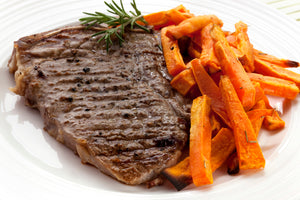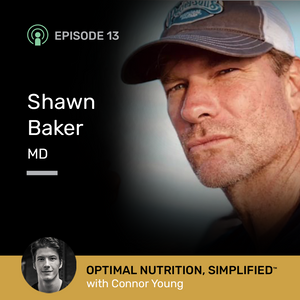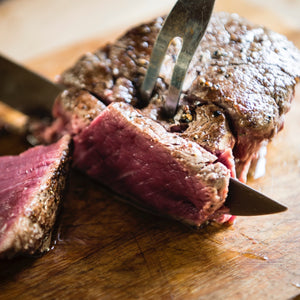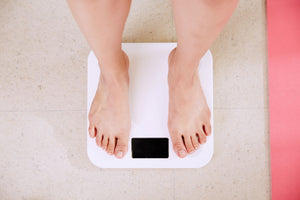Prebiotics And Probiotics For A Healthy Gut Biome
By Connor Young on
Right now, as you read this, an entire ecosystem of bacteria is living in your gut. In fact, you might be more bacterium than human: we have about an equal number of bacteria and human cells, possibly skewed slightly in favor of the little visitors [1].
That sounds strange at first - maybe even alarming - but it’s actually a good thing. Researchers are fascinated by gut bacteria; since 2010 there have been more than 8500 studies on the genus Lactobacillus alone [2]. With all that research, it’s becoming clear that your unique collection of gut bacteria has a huge impact on almost every part of your biology, from fat loss and allergies to muscle growth and mood.
That’s great news, because you have considerable sway over your gut bacteria. You can encourage the friendly ones to grow, weed out the unfriendly ones, and end up with a mix that helps your whole body run better.
When we made Ample, one major focus was balancing gut bacteria. We settled on a two-pronged approach to a stronger gut:
- Probiotics, living good bacteria that colonize your gut after you drink them, and
- Prebiotics, ingredients that your existing beneficial gut bacteria can use for food to help them grow.
We chose a variety of both pre- and probiotics for general gut balance and wellbeing. Here’s how we picked the ones we did, and what each can do for your performance.
In this article, you’ll learn about:
- How probiotics work
- The six best-studied probiotic strains, and what they do
- How to feed your gut bacteria with prebiotics
How probiotics work

Your gut biome (the collection of bacteria in your gut) is endlessly complex. It’s home to trillions of microorganisms that are constantly staking out territory, fighting for land, working together, and taking part in one giant balancing act.
The trouble starts when that balancing act gets out of hand. If one or several bacteria begin to take over your gut, it can have far-reaching consequences. On the other hand, if you take good care of your gut and keep it balanced, you can enhance your body and brain.
One of the simplest, most effective ways to balance your gut is by taking probiotics. Probiotics are live beneficial bacteria in supplement form. When probiotic bacteria reach your small intestine, they start colonizing, crowding out damaging bacteria and strengthening your gut biome.
Research on probiotics and gut bacteria is still young. We’re only at the tip of the iceberg, but a few strains already show consistent benefit. The most beneficial probiotics share a few traits that make them valuable [3]:
- They tolerate acid and bile (otherwise your stomach/digestion will destroy them)
- They’re non-pathogenic (they won’t damage your gut lining or cause disease)
- They’re quick to reproduce (some bacteria are beneficial, but they get overwhelmed by faster-growing bacteria and die out before they can make a difference)
- They produce lactic acid (this isn’t required, but many lactic acid-producing bacteria fight off pathogens in your gut [4] and improve digestion [5])
- They adhere to your gut lining (bacteria are no help if they go right through your system without sticking to your gut)
We added six of the best-studied strains of probiotic bacteria to Ample. Each one fits most or all of the above traits. Here’s a breakdown of what each one does for you:
1) Bacillus coagulans for muscle growth and stable blood sugar
Bacillus coagulans is a common probiotic with several benefits:
- Muscle growth and recovery. People who took B. coagulans had increased protein synthesis after exercise and faster muscle recovery from intense workouts [6]. Pretty cool that a bacterium in your gut can improve muscle recovery in your whole body.
- Anti-inflammation/IBS relief. B. coagulans supports several other beneficial gut bacteria; together, they produce butyrate and acetate, two anti-inflammatory compounds that repair your gut lining and soothe intestinal irritation [7]. That could explain why so many studies have found that B. coagulans helps with irritable bowel syndrome (IBS) [8,9,10,11].
- Blood sugar/insulin balance (in diabetics). In diabetics and pregnant women, B. coagulans improved insulin sensitivity and regulated blood sugar when paired with a prebiotic (more on prebiotics in a minute) [12,13,14]. No studies on healthy humans yet, though.
- Lactose intolerance. If you’re lactose intolerant, B. coagulans could help. It ferments lactose into lactic acid, which can make you better at digesting dairy products [15,16].
2) Bifidobacterium infantis for decreased inflammation
B. infantis is another lactic acid-producing probiotic strain with solid benefits:
- Decreased gut inflammation, pain, gas, bloating, and IBS symptoms. The title sums it up. B. infantis helps improve overall digestion and eases inflammation, pain, gas, bloating, and IBS [17,18].
- Better skin and decreased fatigue. B. infantis fights inflammation beyond your gut, as well. It reversed psoriasis (red, dry, itchy skin) and improved symptoms of chronic fatigue, likely because it’s anti-inflammatory [19].
3) Bifidobacterium lactis (B. animalis) for weight loss, allergies, and immune function
B. lactis covers a lot of different bases:
- Fat burning. Overweight folks who took B. lactis every morning for 45 days saw significant fat loss and decreased inflammatory markers [20]. On top of that, obese people have low levels of B. lactis, and fit people have more of it [21,22]. Taken together, these studies suggest that B. lactis can help keep you in shape.
- Seasonal allergy relief. People with seasonal grass allergies saw significant relief when they took a daily B. lactis supplement [23]. B. lactis seems to regulate your immune system to prevent hyperactive responses to allergens.
- Fighting infections. People with the cold/flu recovered several days faster when they took B. lactis [24].
4) Lactobacillus acidophilus for antibiotic damage and overtraining
L. acidophilus is the most common, and possibly best-studied, probiotic on the market. It’s also one of the oldest probiotics. It’s good for:
- Blood sugar regulation. L. acidophilus improved insulin sensitivity and stabilized blood sugar in diabetics [25].
- Antibiotic-related gut damage. If you have to take antibiotics, consider taking L. acidophilus and the next probiotic on this list, L. rhamnosus. Both decrease GI symptoms and prevent yeast overgrowth in people who take antibiotics [26].
- Diarrhea prevention. L. acidophilus relieved symptoms in people with chronic diarrhea [27].
- Overtraining. Overtrained athletes usually see a marked drop in immune function. L. acidophilus brought their immune function back to normal [28].
5) Lactobacillus rhamnosus for cold/flu immunity
L. rhamnosus is a relative of L. acidophilus with similar benefits:
- Diarrhea prevention. L. rhamnosus prevents or stops diarrhea in a variety of cases: viruses, infections, intestinal damage from antibiotics, and even chemotherapy [29,30, 31, 32]
- Cold/flu immunity. Children at daycare who took L. rhamnosus were significantly less likely to get upper respiratory tract infections [33,34]
6) Lactobacillus paracasei for weight loss and better teeth
The final probiotic in Ample is L. paracasei. It has a few unique effects that extend outside your gut:
- Oral health. L. paracasei improves dental health by blocking out Streptococcus mutans, the main bacterium that causes tooth decay [35,36,37]. L. paracasei also produces an antibacterial compound that destroys bacteria that cause gum disease [38].
- Weight loss. People who took a daily L. paracasei supplement ate significantly fewer calories and reported no change in hunger [39], which could make L. paracasei useful for gradual fat loss.
- Hydrated skin. L. paracasei decreases skin sensitivity and keeps skin hydrated by improving water retention [40,41]. To clarify, people took L. paracasei supplements in these studies, so it seems gut health and skin health are linked.
As you can see, probiotics have all kinds of far-reaching benefits. They’re not the only way to build a stronger gut, though. In fact, probiotic bacteria work especially well when you give them plenty of food to help them grow. That’s where prebiotics come in.
Prebiotics to feed good gut bacteria

Each bottle of Ample contains the six probiotics you just read about. It also contains prebiotics - special types of fiber that you don’t digest, but your gut bacteria love to eat. Beneficial gut bacteria ferment prebiotics into anti-inflammatory compounds that repair your gut lining and create a hostile environment for bad bacteria [42,43]. At the same time, the energy the good gut bacteria get from prebiotics helps them grow, making your gut even more resilient. Prebiotics and probiotics together is an awesome combination.
We added three different prebiotics to Ample:
- Acacia fiber (also called gum arabic) feeds Bifidobacteria and Lactobacilli, which make up 5 of the 6 probiotics in Ample [44]. Acacia fiber also increases satiety and gradual fat loss over time [45].
- Green banana starch is a digestion-resistant starch that your gut bacteria ferment into short-chain fatty acids. Those short-chain fatty acids repair your intestinal lining and are potent anti-inflammatory compounds [46].
- Jerusalem artichoke inulin also ferments into beneficial short-chain fatty acids [47, 48]. It’s especially satiating, too, so it will keep you full for a good long time [49].
Ample is designed to do a lot of things: keep you full for hours, give you high-quality protein and a spectrum of healthy fats, offer convenient nutrition on the go, and make the creatures in your gut happy. Pick up a six-pack of Ample if you haven’t tried it yet. Pardon our shameless plug, and thanks for reading.
← Older Post Newer Post →






Great article! I loved the links to the actual studies.
Melanie Weisberg on